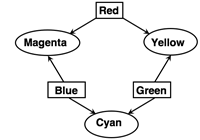The Fundamentals
 This Concept Builder will demand that you understand both color addition and color subtraction. The graphic at the right is a great starting point. It shows the three primary colors of light - red, green, and blue. It also shows the three secondary colors of light - cyan, magenta, and yellow. It is important that you understand that a secondary color of light can be thought of as being equivalent to a mixture of two primary light colors. In other words ...
This Concept Builder will demand that you understand both color addition and color subtraction. The graphic at the right is a great starting point. It shows the three primary colors of light - red, green, and blue. It also shows the three secondary colors of light - cyan, magenta, and yellow. It is important that you understand that a secondary color of light can be thought of as being equivalent to a mixture of two primary light colors. In other words ...
- Magenta light = Red light + Blue light
- Yellow light = Red light + Green light
- Cyan light = Blue light + Green light
This is called color addition.
Now as you approach a question like this one, you think in terms of primary light colors. For instance, you think of magenta light as being red + blue light (or yellow as being red + green light, etc.).
The Incident-Absorbed-Reflected Model
A useful model for analyzing color questions is what we call the incident-absorbed-reflected model. The model suggests that a successful analysis includes three steps ... with each step involving the answering of a question. Those steps or questions are ...
- What primary color(s) of light are incident upon the shirt?
- Of the primary light colors that are incident, which color(s) is/are absorbed by the shirt?
- Of the primary light colors that are incident, which color(s) is/are reflected by the shirt?
The absorbed light color(s) is/are subtracted from the incident light colors. This is called color subtraction. Once the subtraction process is complete, the result is the reflected light color. It is the reflected light color that reaches the observer's eye and determines the color appearance of the shirt.
Applying the Principles
In the example question (see About This Question), we observe in the first two diagrams that the shirt reflects red light and absorbs blue light. (The fact that the shirt is dark when blue light shines on it is an indicator that the shirt is not reflecting the blue light). In the third diagram, we see magenta light shining on the same shirt. We interpret magenta light to be equivalent to red light and blue light. And we know that the shirt reflects red light and absorbs blue light. And so the red light will be the only primary color of light reflected to the observer's eye. This causes the shirt to appear red.
Regardless of which one of the two forms of this question you receive, the thinking will be the same. Interpret everything in terms of primary light colors, determine which primary light colors the shirt absorbs and/or reflects from the first two diagrams, and then apply the information to the third diagram to determine its color appearance.